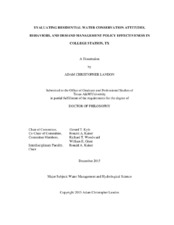| dc.contributor.advisor | Kyle, Gerard T | |
| dc.contributor.advisor | Kaiser, Ronald A | |
| dc.creator | Landon, Adam Christopher | |
| dc.date.accessioned | 2016-04-06T15:57:24Z | |
| dc.date.available | 2017-12-01T06:36:21Z | |
| dc.date.created | 2015-12 | |
| dc.date.issued | 2015-11-17 | |
| dc.date.submitted | December 2015 | |
| dc.identifier.uri | https://hdl.handle.net/1969.1/156178 | |
| dc.description.abstract | In the residential sector managing scarcity requires a shift in patterns of household water use. Voluntary instruments that rely on persuasion and information are some of the most commonly used methods adopted in an effort to change consumer attitudes and behaviors. However, the efficacy of these instruments remains poorly understood. In this dissertation I evaluate the efficacy of an information-based demand management program. This research is based on three questions. 1) Has the program been successful in changing attitudes toward complying with the conservation behaviors that it advocates, and are those attitudes predictive of compliance? 2) What factors lead to the internalization of a personal norm to conserve community resources, and does it result in reduced water use? 3) Has the program been successful in changing patterns of water use, and how have those patterns of water use changed over time?
To address research question one I test the relationship between an intention to comply with the persuasive program and subsequent water use drawing on the integrated model of behavioral prediction. Results indicate that the program was successful in creating positive attitudes toward conservation and that those attitudes predict compliance. To answer research question two I draw on the norm activation model. I hypothesize an extended model that incorporates community attachment as a predictor of personal norms, and contextual factors as predictors of outdoor water use. Results indicate that community attachment is a significant predictor of personal norms and that a personal norm to conserve water is negatively related to water use controlling for contextual factors. I develop a quasi-experimental design to answer research question three. I use a difference-in-difference approach to determine the effects of the persuasive program on actual water consumption over time for households that received the persuasive messages and those that did not. Results indicate that the program had a negative influence on water use and the treatment effect gets stronger over time. However, the treatment effect varies as a function of baseline water use. This work has implications for both the theory of attitude-behavior correspondence, and the practice of managing residential demands for water. | en |
| dc.format.mimetype | application/pdf | |
| dc.language.iso | en | |
| dc.subject | water conservation | en |
| dc.subject | conservation attitudes | en |
| dc.subject | demand management | en |
| dc.subject | policy | en |
| dc.subject | attitude behavior | en |
| dc.title | Evaluating Residential Water Conservation Attitudes, Behaviors, and Demand Management Policy Effectiveness in College Station, TX | en |
| dc.type | Thesis | en |
| thesis.degree.department | Recreation, Park, and Tourism Sciences | en |
| thesis.degree.discipline | Water Management and Hydrological Science | en |
| thesis.degree.grantor | Texas A & M University | en |
| thesis.degree.name | Doctor of Philosophy | en |
| thesis.degree.level | Doctoral | en |
| dc.contributor.committeeMember | Woodward, Richard T | |
| dc.contributor.committeeMember | Grant, William E | |
| dc.type.material | text | en |
| dc.date.updated | 2016-04-06T15:57:24Z | |
| local.embargo.terms | 2017-12-01 | |
| local.etdauthor.orcid | 0000-0001-5643-7832 | |


